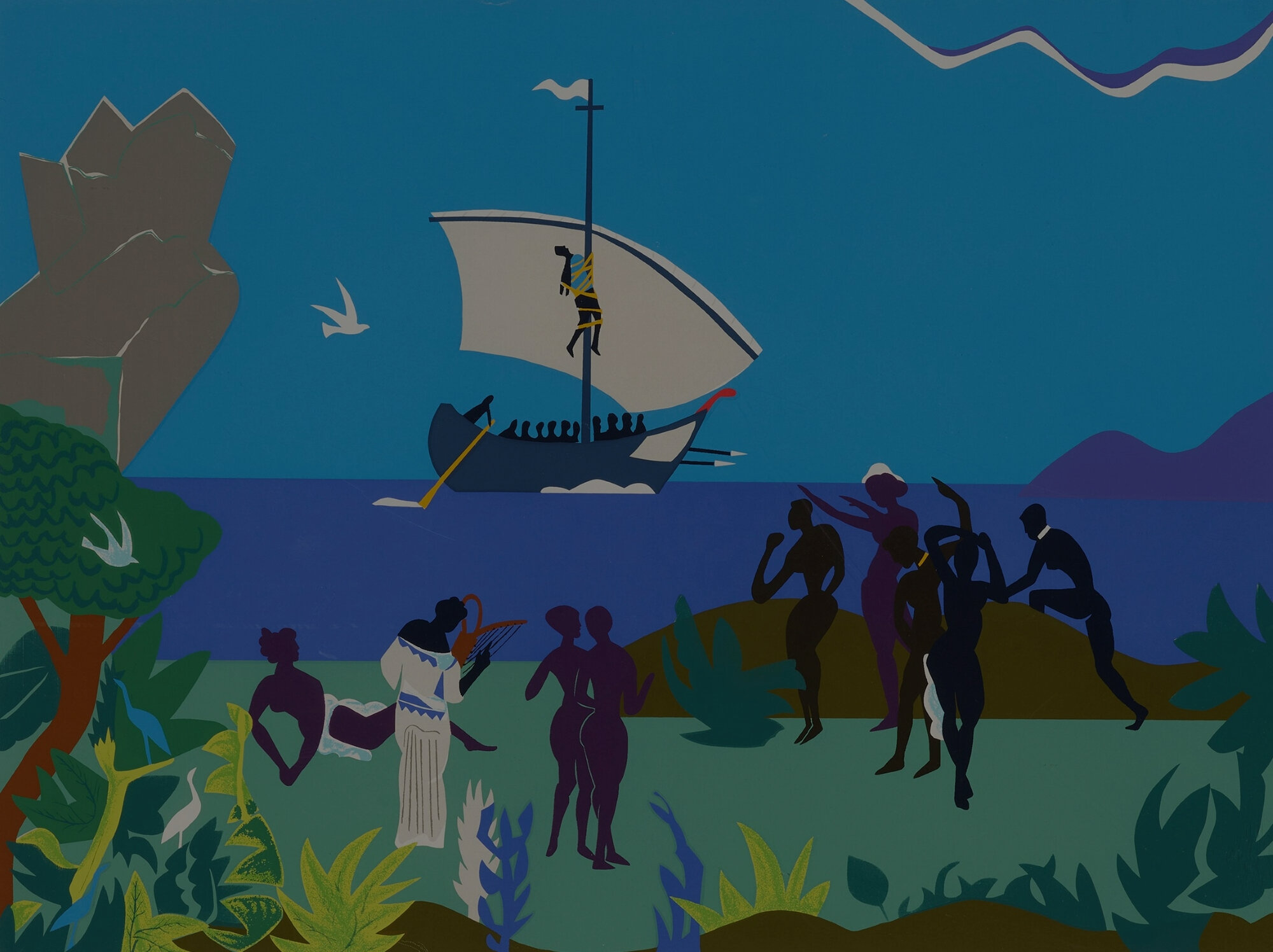271
271
1977
lithograph in colors 27 h × 21 w in (69 × 53 cm)
lithograph in colors 27 h × 21 w in (69 × 53 cm)
estimate: $800–1,200
result: $4,375
follow artist
Printed signature to lower center ‘Romare Bearden’.
The present work was commissioned by TV Guide as a cover illustration for the national broadcast of a miniseries based on Alex Haley's best-selling book of 1976, Roots: The Saga of an American Family. The vibrant colors and disparate parts—a slave ship, the silhouette of Africa, and a striking bust of a man wearing an American flag shirt—dynamically illustrate the complex, difficult heritage and layered tensions of African American identity. As the Smithsonian American Art Museum explains: “By including contemporary, often conflicting, references to historical origins in an image meant for a wide audience, Bearden's work highlights a black history and identity that were becoming widely valued and debated.” Bearden’s work remains more relevant than ever today amidst the continuing struggle for equality and justice for the black community.


When I conjure these memories, they are of the present to me, because after all, the artist is a kind of enchanter in time.
Romare Bearden
Romare Bearden 1911–1988
Multi-genre artist and critic Romare Bearden was born in Charlotte, North Carolina in 1911. He moved with his family to New York City when he was still a young child and attended school in Harlem. During Bearden's adolescence, he briefly lived in Pittsburgh with his grandparents before returning to New York, where his parents were actively involved in the Harlem Renaissance of the 1920s. While Bearden lived in a predominantly Black community, he was actually of mixed African, Cherokee, and Italian ancestry. Nevertheless, he did attend America's second-oldest historically Black college, Lincoln University, in southeastern Pennsylvania as well as Boston University and New York University, from which he earned a degree in education. During college, Bearden was a cartoonist, art director, and editor for various publications. He also studied at the Art Students League in New York and the Sorbonne in Paris. Upon returning to the United States, Bearden was a weekly cartoonist for the Baltimore Afro-American, but he made his living primarily as a social worker for New York's Department of Social Services. He served in this capacity from the mid-1930s to the 1960s.
In his free time, Bearden continued to study and practice art in a determined manner. Not only did he become a member of the Harlem Artists Guild, but he independently explored a wide range of Western art from Italian Renaissance masters to French Impressionists as well as traditional African art, Byzantine mosaics, and certain Asian forms. Bearden had his first solo show in Harlem in 1940. Another one-man exhibition followed in Washington, DC in 1944. Leveraging his diverse range of influences, Bearden worked in several mediums: painting with oils and watercolors, producing collages and photomontages, and making different types of prints. While Bearden regularly explored themes related to the Black experience in America, his works often present an engaging blend of historical, mythological, literary, and musical references. Bearden married Nanette Rohan in 1954 and they set up a second home on St. Martin in the Caribbean, where Rohan's family had roots. In later years, Bearden often depicted island landscapes in his compositions.
Along with generating a significant body of creative work, Bearden wrote art and social criticism. He was named the first art director of the Harlem Cultural Council in 1964 and he later helped establish Harlem's Studio Museum and Cinque Gallery in the East Village, which was geared toward bolstering emerging artists of color. Bearden was one of the founders of the Black Academy of Arts and Letters in 1970 and he was elected to the National Institute of Arts and Letters in 1972. Given his prominent position, Bearden had close relationships with a host of leading Black artists, for example, Duke Ellington, Langston Hughes, Ralph Ellison, James Baldwin, and Alvin Ailey. Although Bearden wrote some music himself and designed costumes and sets for Alvin Ailey, he was best known for his visual art, in particular, his colorfully layered collages, which appeared on the covers of Time and Fortune magazines. Bearden also published books on a range of topics and received several awards, including the National Medal of Arts in 1987, the year before he died. Today examples of Bearden's work are part of the collections of notable institutions, such as the Metropolitan Museum of Art in New York, the Museum of Fine Arts in Boston, and the National Gallery of Art in Washington, DC.
Auction Results Romare Bearden